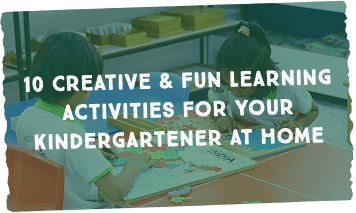Learning about different colour names is crucial for a child’s development. Children lay the basis for their core skills from age 2. They begin identifying the difference between colourful things at an early age. Soon after, they are prepared to learn the names of colours in English. Children with developed core skills enjoy great success in the future, so knowing how to teach kids colour names can set them up for a bright future. Are you searching for how to teach colour names to toddlers? The blog unveils how you can teach children different colour names. Therefore, let’s dive in!
Colours are classified into three main categories:
Kids are always curious about new things and enjoy exploring. To help these little munchkins learn different colour names, try these interactive activities. You can also bundle these together and form a larger lesson plan:
Engaging your kid’s senses is an effective way to help them learn new things. Finger painting is an excellent technique for teaching kids the names of colours in English. Place some pieces of newspaper on your table to prevent spillage and put the painting paper on top. Drench your and their fingers in colours and place them on the painting paper. Start with basic colours and then move on to secondary ones. Talk to them about the colours while doing this activity. Tell them that the fingers are blue while drenching them in blue colour and then applying it on the paper. Once done ask them to tell you about the creation. Motivate them to use colour words while describing.
The scavenger hunt is a perfect activity for children. It is a great way to teach them about the names of colours in English. Draw boxes on a sheet of paper using crayons or coloured pencils. Fill colours in each box and review them with your child. Point to all the boxes on the sheet one by one and ask them to tell you the colour name. Then, ask them to point out objects around your house for every colour. When they find an object ask them to put them in a basket. Continue this activity till the basket is full. Once done, show them all the objects and ask them to tell you the colour names.
The making of a paper picture is a fun and creative way to teach children the names of colours in English. Take coloured papers and cut them into strips. The width can be the same or different. After you have a good pile of coloured strips, help your child stick them to a white sheet of paper to create a design of the kid’s choice. Once done discuss with them about the colourful picture. Tell them the names of each colour. Ask simple yes or no questions like, ‘Did you put the green strip over there?’ or ask them questions like ‘Which colours have you used in the picture?’ You can also do this activity with different shapes such as square, rectangle, triangle, circle, oval etc. instead of strips.
When you teach your children colour names in English, they may connect the same to different objects. If you peel a cucumber and give it to your child to eat, they link it to a green colour. If you show them red and green apples and tell your toddlers about the apples, this will help your child understand that you are talking about the colour and not the object. Try this activity with other similar objects of varying colours.
It can be challenging for a child to learn colour names. Many colours surround us and learning the difference between similar shades is challenging for them. Below are certain tips to help you teach the names of colours in English to your young learners:
Just like adults, kids learn best when they start with foundations. Begin your first lesson with the names of primary colours like blue, yellow, and red. The next day when you begin your lesson, ask them to identify the primary colours. When children get comfortable with the names of primary colours, then move on to the other colours like green, orange, purple, black, white, brown, and grey. You can also make them a colour-mixing sensory bag to practice the different names of colours in English and let them discover the various colours when you combine them. Here’s how you can point out the primary colours in daily life:
Some shades are similar like light red and pink, dark blue and purple. If you choose contrasting colours while playing with them, it is effortless for kids to learn the names. Let’s understand this using an example. If a set of blocks has too many colours, choose 2 to 3 colours among them that are very different like black, red, and white. Ask them to sort these colours. After they successfully figure out these easy names of colours in English, you can move to more striking contrasts.
When you are confident your child has become proficient with basic colours, introduce them to shades like light blue, dark blue, deep green, etc. You are surrounded by most of these colours, so start with them. To help your kid categorise different colours, show them an object near you and tell them the shade. For example, point to the grass and say it’s light green. Similarly point to something darker and say, it’s dark green. Then ask them to point out things of the same colour. When the toddlers point out an object start conversations like is it dark green or light green, or which one is lighter and which is darker. These small conversations help your kids learn the names of colours in English easily.





